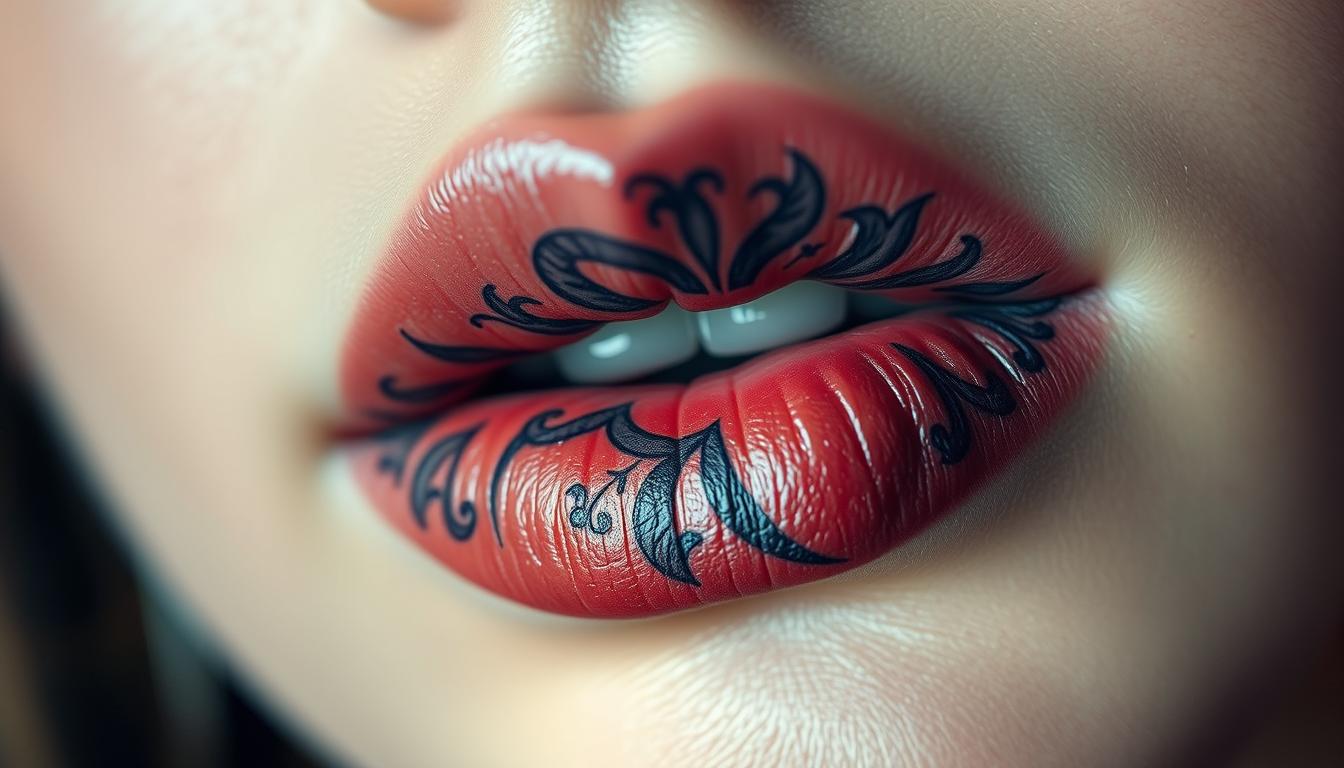
Getting a tattoo on your lip can be a daunting decision, especially when it comes to understanding its permanence. The mouth’s unique environment raises questions about the longevity of lip tattoos. In this comprehensive guide, we’ll explore the truth behind lip tattoo permanence and what factors affect how long they last.
Unlike traditional body tattoos, lip tattoos have distinct characteristics that impact their permanence. We’ll examine both inner lips tattoos and cosmetic lip blushing to understand their differences and what to expect regarding fading, touch-ups, and maintenance.
Key Takeaways
- Lip tattoos have unique characteristics that affect their permanence.
- The mouth’s environment plays a significant role in the longevity of lip tattoos.
- Inner lip tattoos and cosmetic lip blushing have different maintenance requirements.
- Understanding the factors that affect lip tattoo longevity is crucial.
- Proper aftercare is essential for maintaining lip tattoos.
Understanding Lip Tattoos
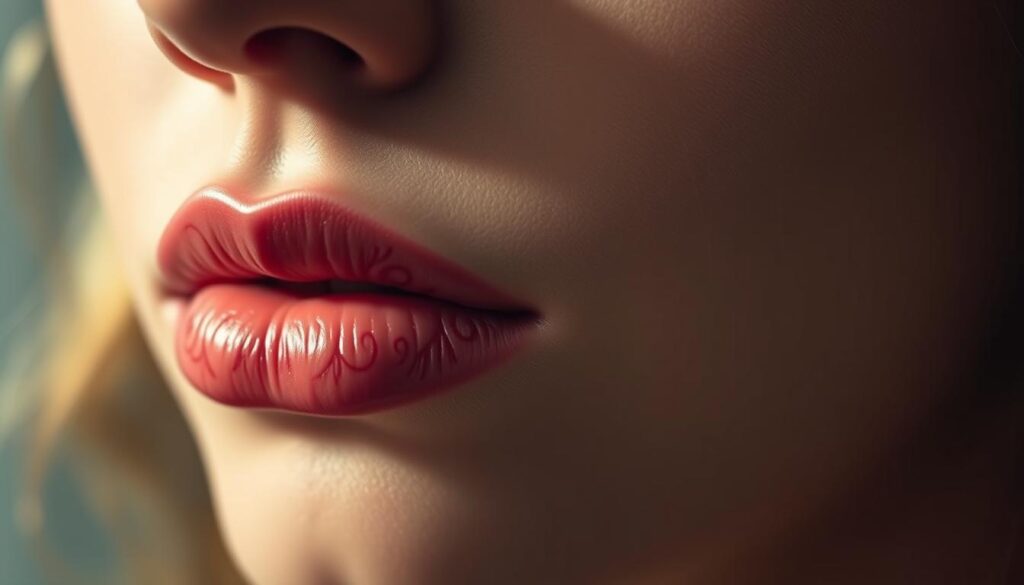
For those considering a lip tattoo, understanding the different types and their purposes is essential. A lip tattoo is a professional procedure that involves inserting color pigments into the lips using small tattooing needles.
Lip tattoos can be categorized into two main types: decorative tattoos and cosmetic tattoos, also known as permanent makeup. Decorative tattoos involve artistic designs, while cosmetic tattoos serve both aesthetic and corrective purposes.
Types of Lip Tattoos
Lip tattoos fall into two main categories. The first category includes decorative tattoos that involve artistic designs. The second category is cosmetic tattoos, which are used for permanent makeup.
- Decorative lip tattoos are artistic designs that can be placed on the inside or outside of the lips.
- Cosmetic lip tattoos help with lip asymmetry, fading color, scarring, or natural pigmentation issues.
Inner Lip vs. Outer Lip Tattoos
The techniques, equipment, and pigments used differ between inner lip and outer lip tattoos due to the different skin environments. Inner lip tattoos are placed on the mucous membrane inside the lower lip and are typically hidden unless the person pulls down their lip to reveal the design.
Do Lip Tattoos Go Away? The Truth About Their Permanence
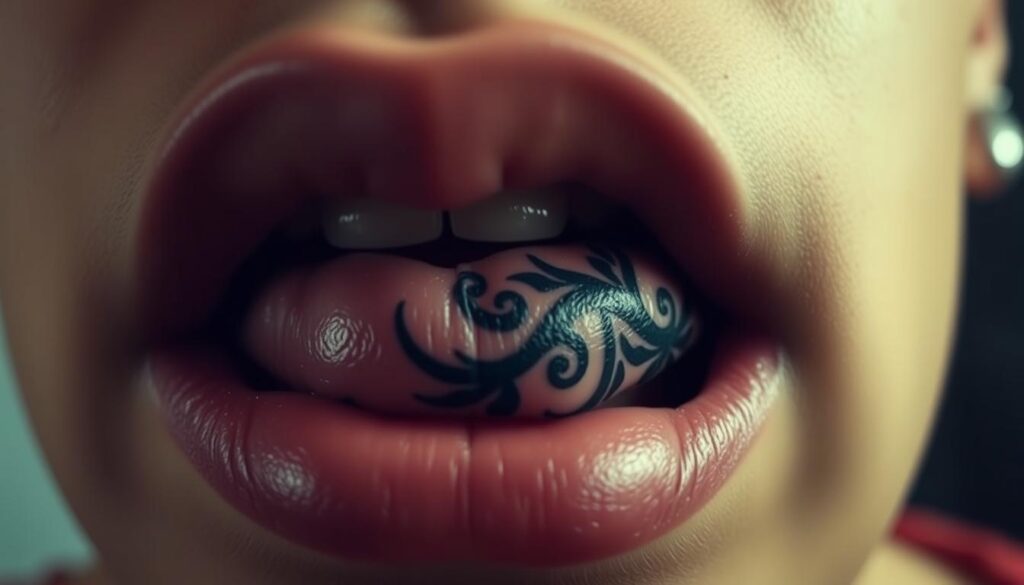
When it comes to lip tattoos, one of the most pressing questions is how long they last. The answer depends on several factors, including the type of lip tattoo and its location.
The skin on the inside of your mouth is designed to constantly regenerate, eroding away from acids and sugars in food and being replaced by your body. This rapid cell turnover affects the longevity of inner lip tattoos.
Inner Lip Tattoo Longevity
Due to the mouth’s mucous membrane’s rapid cell turnover, inner lip tattoos are semi-permanent, typically lasting between 1-5 years. Most people notice significant fading after just one year.
- Semi-permanent nature due to rapid cell turnover
- Significant fading after one year
- Complete disappearance possible over time
Lip Blushing Permanence
Lip blushing, or cosmetic tattooing on the outer lips, generally lasts longer than inner lip tattoos, with an average lifespan of 2-3 years before requiring a refresh.
Neither type of lip tattoo is truly permanent like traditional body tattoos. This semi-permanent nature can be an advantage or disadvantage, allowing for style changes but requiring more maintenance.
Why Lip Tattoos Fade Faster Than Regular Tattoos
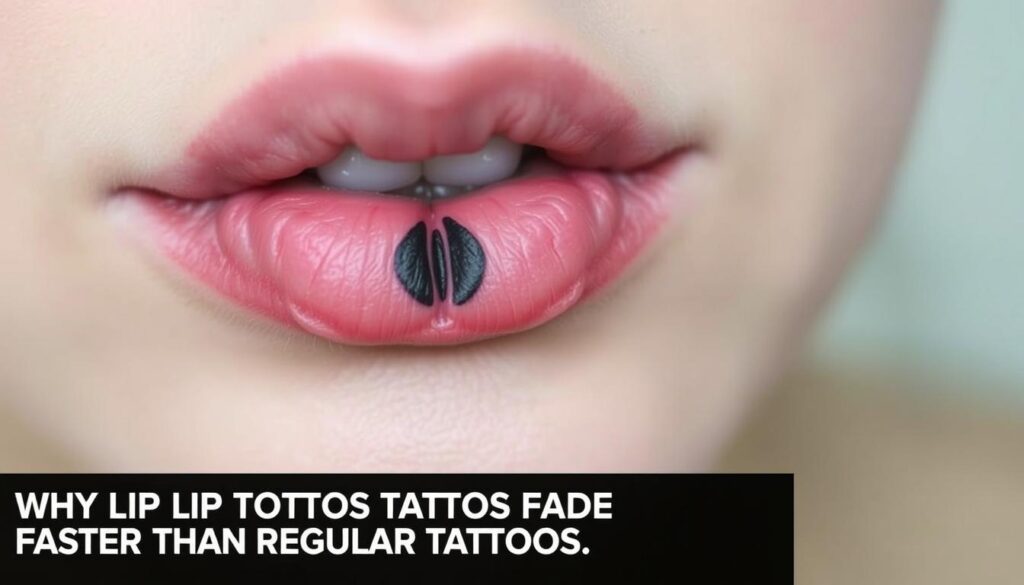
Unlike regular tattoos, lip tattoos face a distinct set of challenges that impact their durability. The mouth’s environment is particularly harsh for tattoos due to its constant moisture, bacteria, and cellular activity.
Mouth Environment and Cell Turnover
The skin inside the mouth is designed to regenerate constantly. This rapid cell turnover means that an inner lip tattoo will typically last around five years. The mucous membranes inside the mouth have significantly faster cell turnover rates than regular skin, causing the tattoo ink to be pushed out more quickly.
Exposure to Food and Drink
Daily exposure to various foods and drinks, especially those that are acidic, spicy, or hot, gradually breaks down the tattoo pigments. The mechanical friction from eating, drinking, and talking also creates constant stress on lip tattoos, contributing to their faster fading.
| Factors Affecting Lip Tattoo Longevity | Impact on Tattoo |
|---|---|
| Mouth Environment | Constant moisture and bacteria accelerate fading |
| Cell Turnover | Rapid cell regeneration pushes out tattoo ink |
| Food and Drink Exposure | Acidic, spicy, or hot substances break down tattoo pigments |
The Healing Process for Lip Tattoos
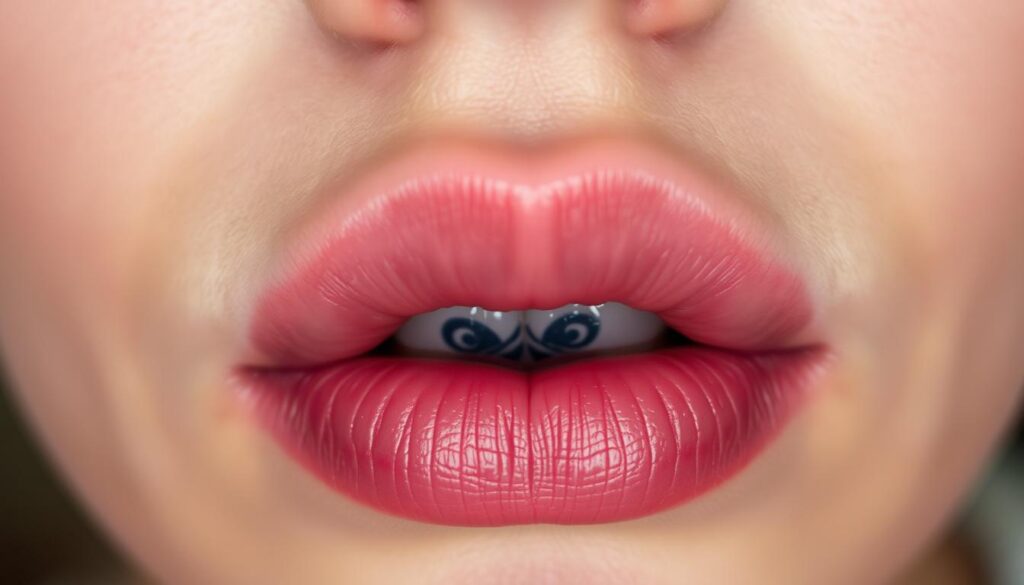
Understanding the healing process for lip tattoos is essential for maintaining their quality and appearance. The healing process is crucial as it directly affects how the tattoo looks after it’s done.
Initial Healing Timeline
The initial healing phase for lip tattoos typically lasts 1-2 weeks. Inner lip tattoos often heal faster due to the naturally moist environment inside the mouth. During the first 24-48 hours, you can expect significant swelling, tenderness, and possibly some bleeding as your body responds to the micro-injuries.
Complete Healing Expectations
Complete healing, where the color settles and the true results become visible, takes approximately 4-6 weeks for most lip tattoos. For outer lip tattoos, also known as lip blushing, the healing process often involves peeling and color changes, with the final shade appearing lighter than immediately after the procedure.
| Healing Stage | Timeline | Characteristics |
|---|---|---|
| Initial Healing | 1-2 weeks | Swelling, tenderness, bleeding |
| Complete Healing | 4-6 weeks | Color settles, peeling, color changes |
Factors That Affect How Long Lip Tattoos Last

The longevity of lip tattoos is influenced by several factors. Understanding these elements can help individuals make informed decisions about their lip tattoos.
Lifestyle Factors
Lifestyle habits play a significant role in determining the lifespan of a lip tattoo. For instance, exposure to the sun can cause the colors to fade faster due to the breakdown of pigments by UV rays. Other lifestyle factors such as smoking, drinking through straws, and consuming hot beverages frequently can also reduce the lifespan of a lip tattoo.
Skin Type and Natural Regeneration
The type of skin and its natural regeneration rate also impact the longevity of lip tattoos. People with oily skin tend to experience faster fading compared to those with dry or normal skin. Moreover, the natural regeneration of skin cells varies among individuals, influenced by factors such as age and health.
| Factor | Impact on Lip Tattoo |
|---|---|
| Sun Exposure | Fades color due to UV rays breaking down pigments |
| Skin Type | Oily skin causes faster fading than dry or normal skin |
| Lifestyle Habits | Smoking, drinking through straws, and hot beverages reduce lifespan |
Proper Aftercare for Longer-Lasting Lip Tattoos
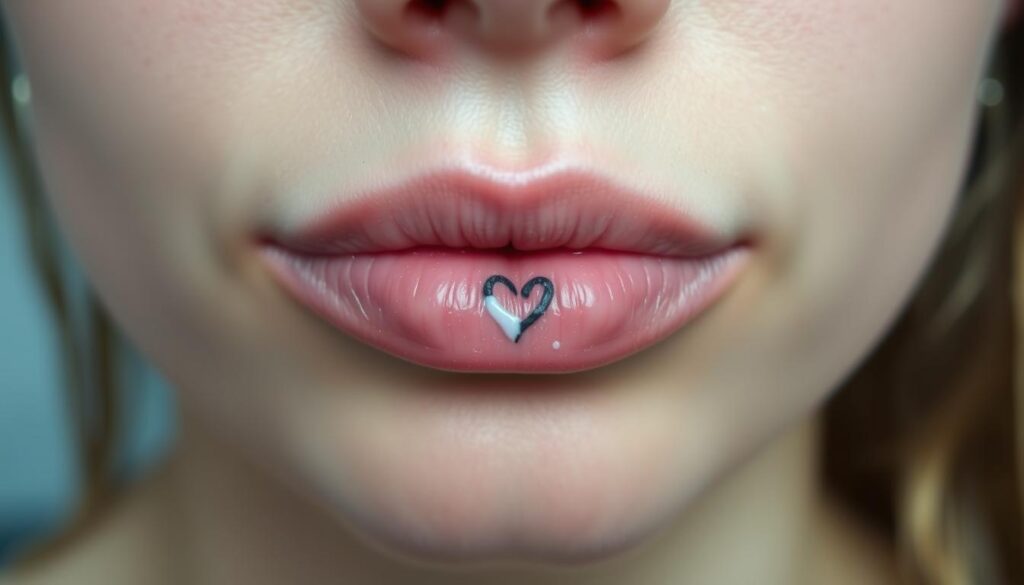
The longevity of your lip tattoo depends significantly on the aftercare routine you follow. Proper care ensures that your tattoo heals well and retains its vibrancy.
Inner Lip Tattoo Aftercare
For inner lip tattoos, using an alcohol-free, dye-free mouthwash after eating or drinking anything besides water is crucial. This helps prevent infection and promotes healing. Aim to swish mouthwash about five times a day.
Outer Lip Tattoo Aftercare
Outer lip tattoos require gentle cleansing with a recommended cleanser and application of a specialized healing balm to maintain moisture. Avoiding makeup and harsh skincare products during the initial healing period is also essential.
| Aftercare Tips | Inner Lip Tattoos | Outer Lip Tattoos |
|---|---|---|
| Cleansing Method | Alcohol-free mouthwash | Gentle cleanser |
| Moisturizing | Not applicable | Specialized healing balm |
| Products to Avoid | Colorants, flavorings | Makeup, exfoliants |
What to Avoid After Getting a Lip Tattoo
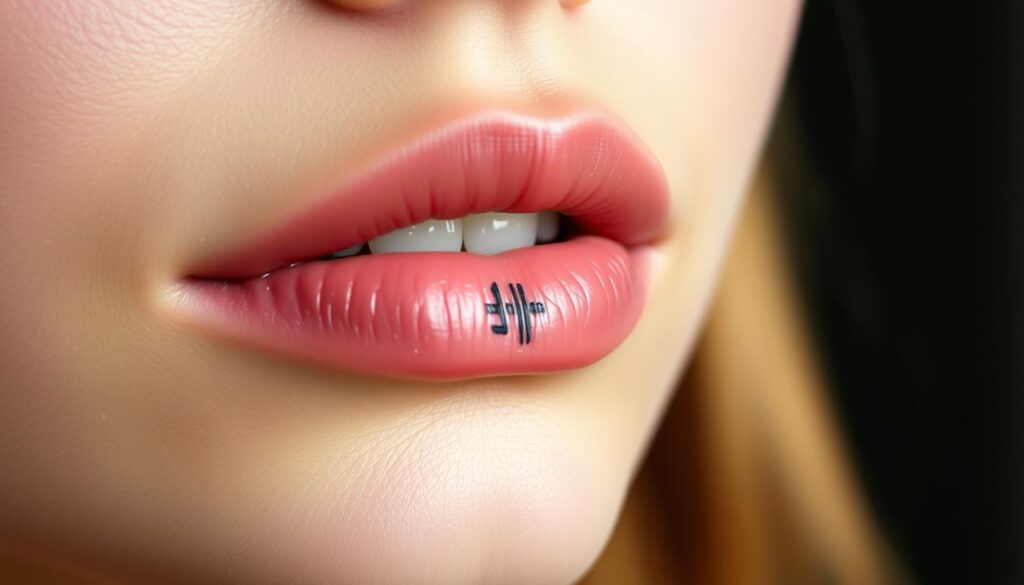
To keep your new lip tattoo looking its best, there are certain things you should avoid. Proper aftercare is crucial for the healing process and longevity of your tattoo.
Foods and Drinks to Skip
For at least two weeks, it’s advisable to avoid consuming spicy, acidic, and hot foods and beverages. These can cause significant pain and potentially damage the healing tattoo. Foods like citrus fruits, tomato sauce, and spicy dishes should be skipped to prevent irritating your lip tattoo.
Activities to Postpone
Certain activities should be postponed to ensure your lip tattoo heals properly. Avoid kissing, oral intimate activities, and aggressive talking for at least 1-2 weeks. Additionally, refrain from smoking and vaping as they introduce harmful chemicals that can affect the tattoo’s quality. Swimming in pools, hot tubs, or natural bodies of water should also be avoided for at least two weeks to prevent infection.
| Activity | Recommended Avoidance Time |
|---|---|
| Eating spicy/acidic foods | At least 2 weeks |
| Kissing and oral activities | 1-2 weeks |
| Smoking and vaping | As long as possible |
| Swimming | At least 2 weeks |
Risks and Side Effects of Lip Tattoos
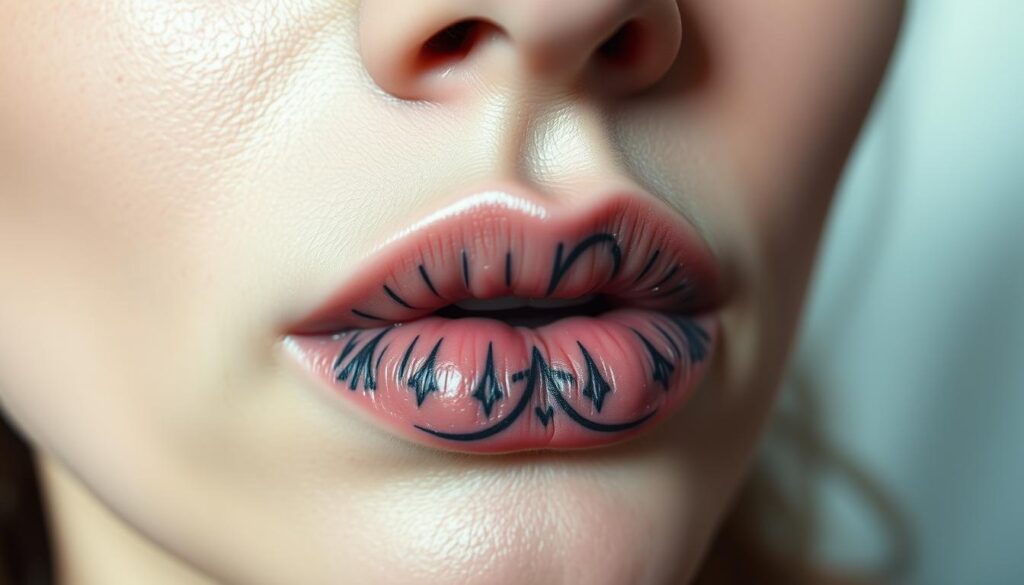
Understanding the potential risks and side effects is crucial before deciding to get a lip tattoo. While generally considered safe when done by a professional, lip tattoos can have adverse effects.
Common Side Effects
Common side effects of lip tattoos include swelling, redness, bruising, and tenderness, which typically subside within 3-7 days. Swelling is a natural reaction to the micro-injuries caused by tattoo needles, and cold packs can help alleviate it.
- Swelling and redness
- Bruising and tenderness
Potential Complications
More serious complications can occur, including infection, allergic reactions to pigments, and scarring. Infection is a significant risk due to the mouth’s bacteria-rich environment, especially for inner-lip tattoos. Ensuring your tattoo artist uses sterilized equipment and following aftercare instructions are crucial to minimizing this risk.
The Lip Tattoo Procedure: What to Expect
Getting a lip tattoo is a multi-step process that requires precision and care. The procedure involves a skilled tattoo artist who will guide you through the process.
Pain Level and Duration
The lip tattoo procedure typically takes 1-2 hours, depending on the complexity of the design and whether it’s an inner or outer lip tattoo. Pain levels are generally higher for lip tattoos compared to other body areas due to the high concentration of nerve endings in the lips.
| Procedure Step | Description | Duration |
|---|---|---|
| Design Creation | The artist creates a stencil of the design. | 15 minutes |
| Tattooing | The artist uses a tattoo machine to insert pigment into the skin. | 1-2 hours |
| Aftercare | The artist provides instructions for post-procedure care. | 10 minutes |
Preparation Tips
To ensure a smooth tattoo session, it’s essential to prepare properly. Avoid blood thinners, including alcohol and certain medications, for 24-48 hours before your appointment. Arrive with clean, moisturized lips to get ready for your tattoo.
Touch-Ups and Maintenance: Keeping Your Lip Tattoo Fresh
Maintaining the vibrancy of your lip tattoo requires periodic touch-up sessions. This is because lip tattoos, especially those on the inner lip, tend to fade faster due to the mouth environment and cell turnover. Regular maintenance ensures that your lip tattoo remains fresh and vibrant.
When to Schedule Touch-Ups
Inner lip tattoos typically require touch-ups every 6-12 months to maintain their appearance. Lip blushing and outer lip tattoos generally need refreshing every 1-3 years, depending on individual factors and desired vibrancy. Scheduling touch-ups at these intervals helps maintain the color and appeal of your lip tattoo.
Cost Considerations for Long-Term Maintenance
The cost for touch-ups is usually lower than the initial procedure, with many artists offering scaled pricing based on how recently the original tattoo was done. For instance, DAELA Cosmetic Tattoo has a scaled touch-up pricing menu, where the less time between appointments, the lower your price. Long-term maintenance costs should be factored into your decision to get a lip tattoo.
Conclusion: Is a Lip Tattoo Right for You?
For those contemplating a lip tattoo, understanding the process and aftercare is vital. Lip tattoos offer a unique form of self-expression, but they require more maintenance and have a shorter lifespan than traditional tattoos. To achieve the best results, it’s crucial to choose a reputable artist who specializes in lip tattoos. By following aftercare instructions and scheduling regular touch-ups, you can enjoy your lip tattoo and make sure it remains vibrant. Ultimately, lip tattoos can be a rewarding experience for many people.
